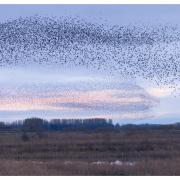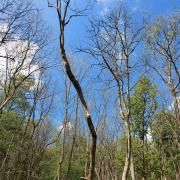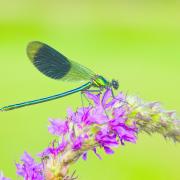Attempts are being made to return a rare regal creature to its Yorkshire habitat
raham Jackson, who works for the Forestry Commission, has become a keen wildlife photographer, tracking the fortunes of butterflies in Dalby.
He is part of a team working to lure one of Yorkshire’s rarest butterflies back to its former haunt. The striking yellow and brown flecked Duke of Burgundy (hamearis lucina) survives in only a handful of places in the north. Until recently one of these was Pexton Bank in 3,400-hectare (8,600-acre) Dalby Forest, near Pickering, but there have been no sightings for the past five years.
Attempts are now being made by the Forestry Commission, working with Butterfly Conservation, to encourage the colourful creature to return. Improvements to their habitat have just been completed, supported by WREN, the conservation arm of a landfill company working with Butterfly Conservation, involving felling trees and cutting back over-grown scrub, both of which may have shaded out some of the flowers the butterfly relies on. Cowslip and primrose are particularly important as the duke lays its eggs on the undersides of their leaves, which also provide food for larvae.
‘This is a rare species and for many years the jewel in the crown of Pexton Bank, which is an outstanding place for butterflies with over 20 recorded species,’ said district forester Paul Cody. ‘But when wildlife becomes isolated and fragmented it is always vulnerable. That’s why it’s important we continue our push to improve the environment and link habitats together. We’ve got our fingers crossed that the duke makes a regal return.’
The butterfly has very specific requirements, preferring scrubby grasslands and sunny woodland clearings. Habitat loss is thought to be a major factor behind its national decline – colony numbers are estimated to have decreased by over half in the last 40 years. The only other known populations in Yorkshire are near Helmsley, with just one site on the east of the North York Moors National Park.
David Wainwright from Butterfly Conservation said: ‘The Duke of Burgundy has been giving cause for concern for a number of years, both locally and nationally. We hope that the ongoing conservation work at Pexton Bank will be the first step in re-establishing the species in the Pickering area and beyond.’
The Duke of Burgundy is found in small numbers scattered throughout southern England and the southern Lake District.
Butterfly Conservation has won a �230,000 grant to manage 34 different sites in the North York Moors over the next five years to benefit the Duke of Burgundy and pearl-bordered fritillary.
The Forestry Commission and Butterfly Conservation are committed to conserving and increasing butterfly numbers and moths in the nation’s woodlands. Four years ago a plan was launched outlining a new strategy.
It identified 140 Forestry Commission woods in England as key butterfly and moth sites – with half designated as A grade priority locations, as they support some of the UK’s most endangered species. These include Dalby Forest, Cropton Forest, Bumble Wood and Langdale, near Pickering, Harwood Dale, near Scarborough, Bishop Wood, near Cawood, Selby, and Sneaton Forest, near Whitby.


























